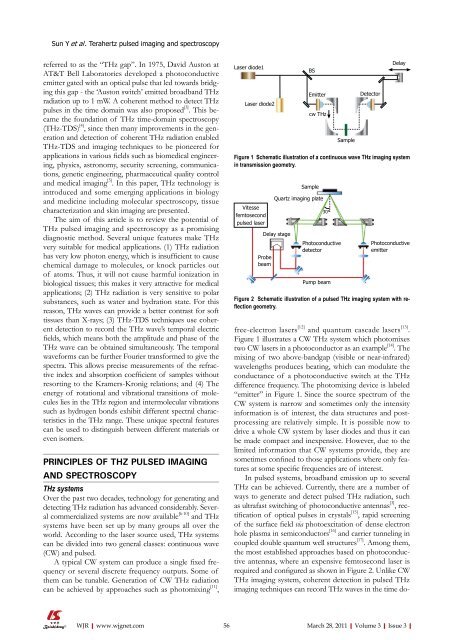3 - World Journal of Gastroenterology
3 - World Journal of Gastroenterology
3 - World Journal of Gastroenterology
You also want an ePaper? Increase the reach of your titles
YUMPU automatically turns print PDFs into web optimized ePapers that Google loves.
Sun Y et al . Terahertz pulsed imaging and spectroscopy<br />
referred to as the “THz gap”. In 1975, David Auston at<br />
AT&T Bell Laboratories developed a photoconductive<br />
emitter gated with an optical pulse that led towards bridging<br />
this gap - the ‘Auston switch’ emitted broadband THz<br />
radiation up to 1 mW. A coherent method to detect THz<br />
pulses in the time domain was also proposed [3] . This became<br />
the foundation <strong>of</strong> THz time-domain spectroscopy<br />
(THz-TDS) [4] , since then many improvements in the generation<br />
and detection <strong>of</strong> coherent THz radiation enabled<br />
THz-TDS and imaging techniques to be pioneered for<br />
applications in various fields such as biomedical engineering,<br />
physics, astronomy, security screening, communications,<br />
genetic engineering, pharmaceutical quality control<br />
and medical imaging [5] . In this paper, THz technology is<br />
introduced and some emerging applications in biology<br />
and medicine including molecular spectroscopy, tissue<br />
characterization and skin imaging are presented.<br />
The aim <strong>of</strong> this article is to review the potential <strong>of</strong><br />
THz pulsed imaging and spectroscopy as a promising<br />
diagnostic method. Several unique features make THz<br />
very suitable for medical applications. (1) THz radiation<br />
has very low photon energy, which is insufficient to cause<br />
chemical damage to molecules, or knock particles out<br />
<strong>of</strong> atoms. Thus, it will not cause harmful ionization in<br />
biological tissues; this makes it very attractive for medical<br />
applications; (2) THz radiation is very sensitive to polar<br />
substances, such as water and hydration state. For this<br />
reason, THz waves can provide a better contrast for s<strong>of</strong>t<br />
tissues than X-rays; (3) THz-TDS techniques use coherent<br />
detection to record the THz wave’s temporal electric<br />
fields, which means both the amplitude and phase <strong>of</strong> the<br />
THz wave can be obtained simultaneously. The temporal<br />
waveforms can be further Fourier transformed to give the<br />
spectra. This allows precise measurements <strong>of</strong> the refractive<br />
index and absorption coefficient <strong>of</strong> samples without<br />
resorting to the Kramers-Kronig relations; and (4) The<br />
energy <strong>of</strong> rotational and vibrational transitions <strong>of</strong> molecules<br />
lies in the THz region and intermolecular vibrations<br />
such as hydrogen bonds exhibit different spectral characteristics<br />
in the THz range. These unique spectral features<br />
can be used to distinguish between different materials or<br />
even isomers.<br />
PRINCIPLES OF THZ PULSED IMAGING<br />
AND SPECTROSCOPY<br />
THz systems<br />
Over the past two decades, technology for generating and<br />
detecting THz radiation has advanced considerably. Several<br />
commercialized systems are now available [6-10] and THz<br />
systems have been set up by many groups all over the<br />
world. According to the laser source used, THz systems<br />
can be divided into two general classes: continuous wave<br />
(CW) and pulsed.<br />
A typical CW system can produce a single fixed frequency<br />
or several discrete frequency outputs. Some <strong>of</strong><br />
them can be tunable. Generation <strong>of</strong> CW THz radiation<br />
can be achieved by approaches such as photomixing [11] ,<br />
WJR|www.wjgnet.com<br />
Laser diode1<br />
Laser diode2<br />
BS<br />
Emitter<br />
cw THz<br />
Sample<br />
Detector<br />
Delay<br />
Figure 1 Schematic illustration <strong>of</strong> a continuous wave THz imaging system<br />
in transmission geometry.<br />
Vitesse<br />
femtosecond<br />
pulsed laser<br />
Delay stage<br />
Probe<br />
beam<br />
Sample<br />
Quartz imaging plate<br />
Photoconductive<br />
emitter<br />
free-electron lasers [12] and quantum cascade lasers [13] .<br />
Figure 1 illustrates a CW THz system which photomixes<br />
two CW lasers in a photoconductor as an example [14] . The<br />
mixing <strong>of</strong> two above-bandgap (visible or near-infrared)<br />
wavelengths produces beating, which can modulate the<br />
conductance <strong>of</strong> a photoconductive switch at the THz<br />
difference frequency. The photomixing device is labeled<br />
“emitter” in Figure 1. Since the source spectrum <strong>of</strong> the<br />
CW system is narrow and sometimes only the intensity<br />
information is <strong>of</strong> interest, the data structures and postprocessing<br />
are relatively simple. It is possible now to<br />
drive a whole CW system by laser diodes and thus it can<br />
be made compact and inexpensive. However, due to the<br />
limited information that CW systems provide, they are<br />
sometimes confined to those applications where only features<br />
at some specific frequencies are <strong>of</strong> interest.<br />
In pulsed systems, broadband emission up to several<br />
THz can be achieved. Currently, there are a number <strong>of</strong><br />
ways to generate and detect pulsed THz radiation, such<br />
as ultrafast switching <strong>of</strong> photoconductive antennas [3] , rectification<br />
<strong>of</strong> optical pulses in crystals [15] , rapid screening<br />
<strong>of</strong> the surface field via photoexcitation <strong>of</strong> dense electron<br />
hole plasma in semiconductors [16] and carrier tunneling in<br />
coupled double quantum well structures [17] . Among them,<br />
the most established approaches based on photoconductive<br />
antennas, where an expensive femtosecond laser is<br />
required and configured as shown in Figure 2. Unlike CW<br />
THz imaging system, coherent detection in pulsed THz<br />
imaging techniques can record THz waves in the time do-<br />
56 March 28, 2011|Volume 3|Issue 3|<br />
30°<br />
Photoconductive<br />
detector<br />
Pump beam<br />
Figure 2 Schematic illustration <strong>of</strong> a pulsed THz imaging system with reflection<br />
geometry.

















